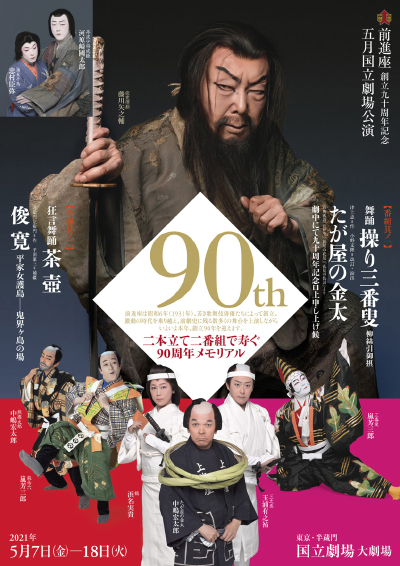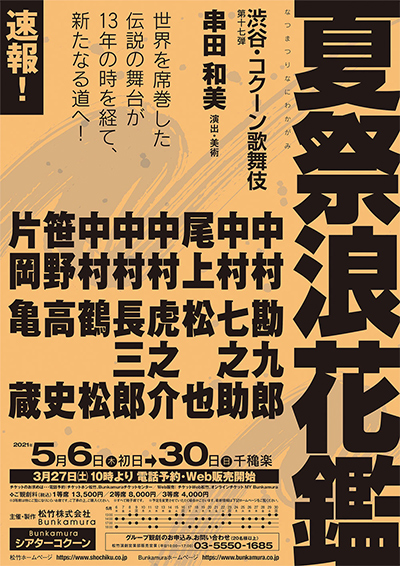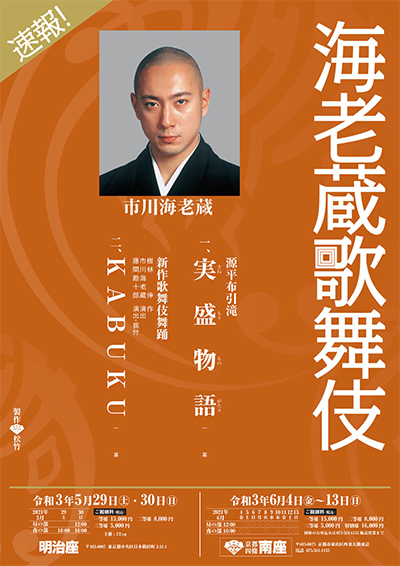| Casting |
Living National Treasure Onoe Kikugor˘, Living National Treasure Nakamura Kichiemon, Living National Treasure Nakamura T˘z˘, Nakamura Tokiz˘, Nakamura Jakuemon, Nakamura Kaishun, Onoe Kikunosuke, Nakamura Kinnosuke, Ichikawa Ennosuke, Onoe Sh˘roku, Ichikawa Sadanji, Nakamura Matagor˘,
Band˘ Minosuke, Nakamura Hayato, Nakamura Baishi, Onoe Ukon, Band˘ Kamez˘, Nakamura Mantar˘, Onoe Ushinosuke, Band˘ Kamesabur˘
|
| Comments |
No great yearly Dankiku festival this year for the Naritaya and Otowaya guilds, which usually commemorates in May 2 great stars of
the Meiji era: Dan = Ichikawa Danjűr˘ IX
and Kiku = Onoe Kikugor˘ V. The Otowaya guild is present with 3 generations of actors but not the Naritaya guild.
The performances from the 3rd to the 11th of may 2021 are cancelled because of the third state of emergency declared by Japan's central government due to the COVID-19 pandemic.
Sannin Kichisa:
(Three Thieves Named Kichisa)
The playwright Kawatake Mokuami excelled at portrayals of thieves and this short scene,
with its music and poetic lines, is one of his most famous.
A beautiful young woman helps out a woman who is lost on the road.
But she is actually Oj˘ Kichisa, a male thief who is disguised as a woman.
He steals an immense sum of money that the woman is carrying and this leads to
an encounter on this riverbank of three thieves, all with the name Kichisa.
The two others Kichisa are Osh˘ Kichisa, a bonze turned thief, and Ob˘ Kichisa, an ex-samurai turned thief
Though they start out as rivals, they decide to become blood brothers
and form a gang. Featuring Onoe Ukon as Oj˘ Kichisa, Band˘ Minosuke as Osh˘ Kichisa and Nakamura Hayato as Ob˘ Kichisa.
Tsuchi-gumo: a dance play adapted from the classical N˘ theatre.
The samurai Lord Minamoto Raik˘ is famous in legend for ridding Ky˘to of demons.
While Raik˘ is confined to bed with illness, a priest (Onoe Sh˘roku) from a prominent
temple comes to pray for his health. In fact, the priest is actually the spirit
of the earth spider which has caused Raik˘'s illness in the first place
and hopes to destroy him. The spider's plan to kill Raik˘ is defeated
by his retainers (the famous shitenn˘) in an exciting fight.
Featuring Ichikawa Ennosuke as Raik˘.
Michiyuki Tabiji no Hanamuko: here are few plays more popular in Kabuki than "Kanadehon Chűshingura" ('The Treasury of Loyal Retainers').
This is based on a true incident in which a feudal lord attacked another in the Sh˘gun's palace and was
immediately sentenced to commit ritual suicide and his domain was confiscated. In this dance, after
the death of his lord, the retainer Kanpei (Nakamura Kinnosuke) and his lover, the lady-in-waiting Okaru (Nakamura Baishi) flee to Okaru's home,
a farmer's house in the country. Kanpei feels responsible for the calamity which befell his lord
because at the crucial time he was having a romantic tryst and was not at his master's side.
He tries to commit suicide but Okaru stops him and convinces him that they should go to her home
as husband and wife and wait for the right moment for him to apologize.
Kanpei Harakiri: the retainer Kanpei (Living National Treasure Onoe Kikugor˘) lives a poor life with Okaru at her parents' rural home.
He desperately wants to take part in the vendetta against his lord's enemy, but must come up
with the money necessary to finance his part in it. Secretly, Okaru (Nakamura Tokiz˘) and her family decide that
the only way to raise the money is to sell her to the pleasure quarters. On a lonely highway,
while Okaru's father is on his way home from sealing the deal a thief named Sadakur˘ kills him and
steals the money. In a bizarre twist of events, however, Kanpei then kills the robber accidentally while
out hunting and he finds the money. Later, the fabric of the wallet seems to prove that Kanpei has murdered
his father-in-law. Kanpei takes responsibility for both the death of his father-in-law and also for being absent
when his lord needed him, and commits ritual suicide. Featuring also Living National Treasure Nakamura T˘z˘, Ichikawa Sadanji, Nakamura Kaishun and Nakamura Matagor˘.
Hachijin: this is a jidaimono period
piece that dramatizes true historical events. Kat˘ Kiyomasa (1562~1611) was one
of the fiercest generals under Toyotomi Hideyoshi and continued to defend
the family and Hideyoshiĺs young heir Hideyori even after the world came to
be ruled by crafty Tokugawa Ieyasu, who searched for any excuse he could find
to destroy the clan of his most powerful rival. In the Edo period,
the Shogunate banned all mention of contemporary events on stage and was
especially sensitive to all mention of the Toyotomi clan and anyone associated
with it. On stage, Kat˘ Kiyomasa always appeared under the thinly disguised
name of Sat˘ Masakiyo. In this play, the aged Masakiyo defends the young
heir of his late lord when he is summoned to a meeting with an old feudal
lord who now rules the land. Masakiyo does not budge from his post even
when he is weakened by poison. Starring Nakamura Karoku (instead of Living National Treasure Nakamura Kichiemon) and Nakamura Jakuemon as
Masakiyo and Hinaginu (the wife of Masakiyo's son).
Kagami Jishi: one of the most important dances for onnagata female
role specialists and is an audience favorite. The maidservant Yayoi performs an
auspicious lion dance for the Sh˘gun in his opulent palace, but she gradually finds
herself under the control of the lion spirit. In the second half of the dance,
the lion spirit itself appears and performs its crazed dance among peonies and
fluttering butterflies. Starring Onoe Kikunosuke as both Yayoi and the spirit of the lion.
Sources: Earphone Guide Website or Sh˘chiku Kabuki Official Website
|






